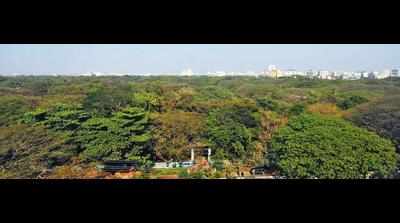- News
- City News
- kochi News
- Mangalavanam sanctuary gasps for breath
Trending
This story is from June 26, 2019
Mangalavanam sanctuary gasps for breath
With more and more entities executing high-rise projects around the Mangalavanam Bird Sanctuary, the future for the state’s only coastal protected area, which witnessed vanishing of heronries — Black-crowned Night heron and Little Cormorant — despite regeneration of mangroves within the sanctuary, looks bleak.

The issues faced by Mangalavanam Bird Sanctuary, with an area of just 2.74 ha, should be addressed through adaptive management strategies
KOCHI: With more and more entities executing high-rise projects around the Mangalavanam Bird Sanctuary, the future for the state’s only coastal protected area, which witnessed vanishing of heronries — Black-crowned Night heron and Little Cormorant — despite regeneration of mangroves within the sanctuary, looks bleak.
The sanctuary, with an area of just 2.74 ha, has been facing degradation of physical environment due to heavy sedimentation as a result of dredging activity in the coast.
Six months ago, Bharat Petroleum Corporation Ltd (BPCL) completed building a multi-storied staff quarters on their land next to Mangalavanam area, which was marked as eco-sensitive zone (ESZ) as per a draft notification. The Southern Railway has plans to renovate the old railway station and had recently replaced the tracks. Last week, Kerala State Housing Board (KSHB) announced a mega project – Rs 3,105-crore Kerala Exhibition City – to be built in public private partnership (PPP) mode, with high-rise buildings that critics say would choke the last available flight path of the birds.
Mangalavanam Bird Sanctuary, a tidal wetland area with shallow lake in the middle, lined by thick mangrove vegetation, is facing a host of issues apart from this which needs to be addressed through adaptive management strategies.
But the sedimentation, presence of canopy-rich exotic species in the sanctuary and the pressure exerted by civil constructions in the periphery have also resulted in the inward growth of mangroves.
The analysis of vegetation cover using Google images by Sacon indicated that over a period of 15 years (2002 to 2017) the water spread area as viewed aerially in the sanctuary came down by 50%. “Birds look for presence of large waterbodies and this could be reason why they stopped choosing the area for breeding and roosting,” said principal scientist at Sacon P V Karunakaran, who led the team which assessed the Mangalavanam habitat.
“The available terrestrial area of the sanctuary is already occupied by huge trees with large canopies. We had also suggested thinning the canopy of exotic species to allow the mangroves to grow outward. Desiltation may not be of much use as the cycle would keep repeating,” said Karunakaran.
In January, 2018, the sanctuary officials tried to desilt the lake with help from Kochi corporation but the project was abandoned midway as the contractor felt that manual cleaning of sludge was not profitable. “The contractor wanted to use an earthmover which couldn’t be permitted,” said an official.
The sanctuary, with an area of just 2.74 ha, has been facing degradation of physical environment due to heavy sedimentation as a result of dredging activity in the coast.
Six months ago, Bharat Petroleum Corporation Ltd (BPCL) completed building a multi-storied staff quarters on their land next to Mangalavanam area, which was marked as eco-sensitive zone (ESZ) as per a draft notification. The Southern Railway has plans to renovate the old railway station and had recently replaced the tracks. Last week, Kerala State Housing Board (KSHB) announced a mega project – Rs 3,105-crore Kerala Exhibition City – to be built in public private partnership (PPP) mode, with high-rise buildings that critics say would choke the last available flight path of the birds.
Mangalavanam Bird Sanctuary, a tidal wetland area with shallow lake in the middle, lined by thick mangrove vegetation, is facing a host of issues apart from this which needs to be addressed through adaptive management strategies.
A major concern is a sewage canal that flows through the sanctuary, which is contributing to the organic load and sedimentation of tidal flats. A habitat assessment study by Salim Ali Centre for Ornithology and Natural History (Sacon) in 2017 had recommended that the sewage canal be diverted. “We had requested the Kochi corporation to divert the canal but there was no action,” said an official attached to the Mangalavanam sanctuary. The report said in order to enrich the food species (plankton, fish, mollusks, etc) for the birds in the sanctuary, the sediments should be devoid of pollution.
But the sedimentation, presence of canopy-rich exotic species in the sanctuary and the pressure exerted by civil constructions in the periphery have also resulted in the inward growth of mangroves.
The analysis of vegetation cover using Google images by Sacon indicated that over a period of 15 years (2002 to 2017) the water spread area as viewed aerially in the sanctuary came down by 50%. “Birds look for presence of large waterbodies and this could be reason why they stopped choosing the area for breeding and roosting,” said principal scientist at Sacon P V Karunakaran, who led the team which assessed the Mangalavanam habitat.
“The available terrestrial area of the sanctuary is already occupied by huge trees with large canopies. We had also suggested thinning the canopy of exotic species to allow the mangroves to grow outward. Desiltation may not be of much use as the cycle would keep repeating,” said Karunakaran.
In January, 2018, the sanctuary officials tried to desilt the lake with help from Kochi corporation but the project was abandoned midway as the contractor felt that manual cleaning of sludge was not profitable. “The contractor wanted to use an earthmover which couldn’t be permitted,” said an official.
End of Article
FOLLOW US ON SOCIAL MEDIA










